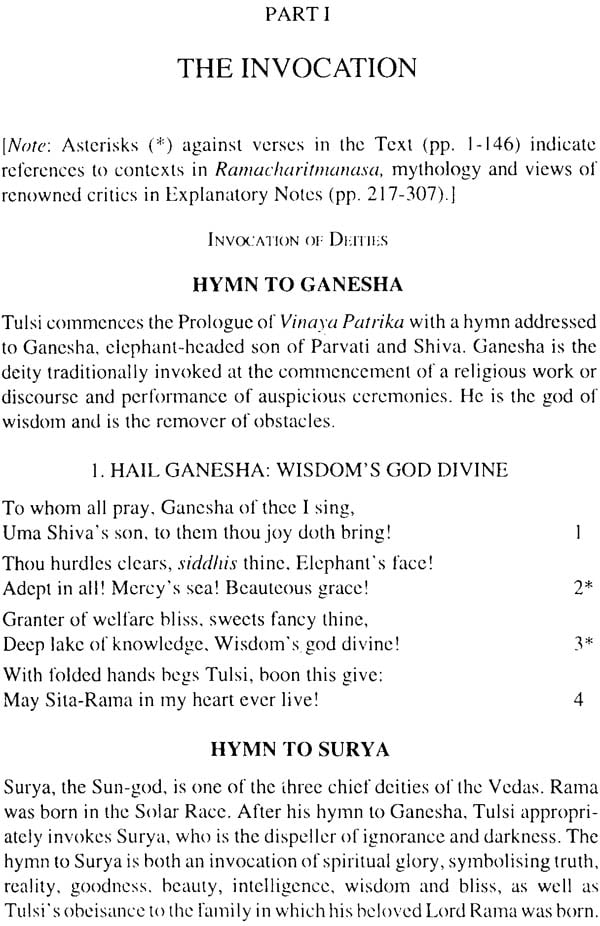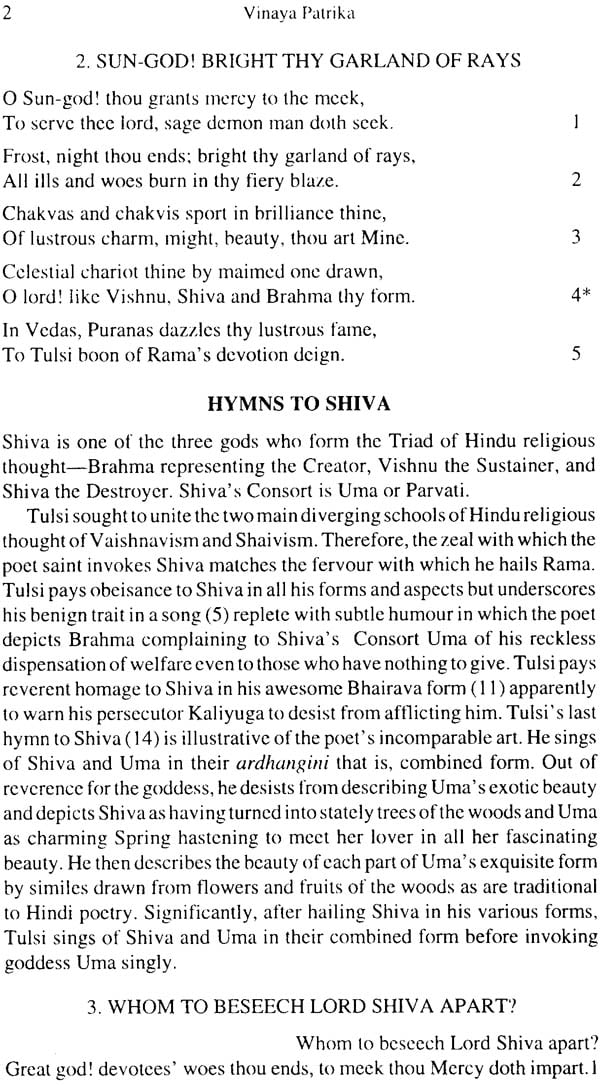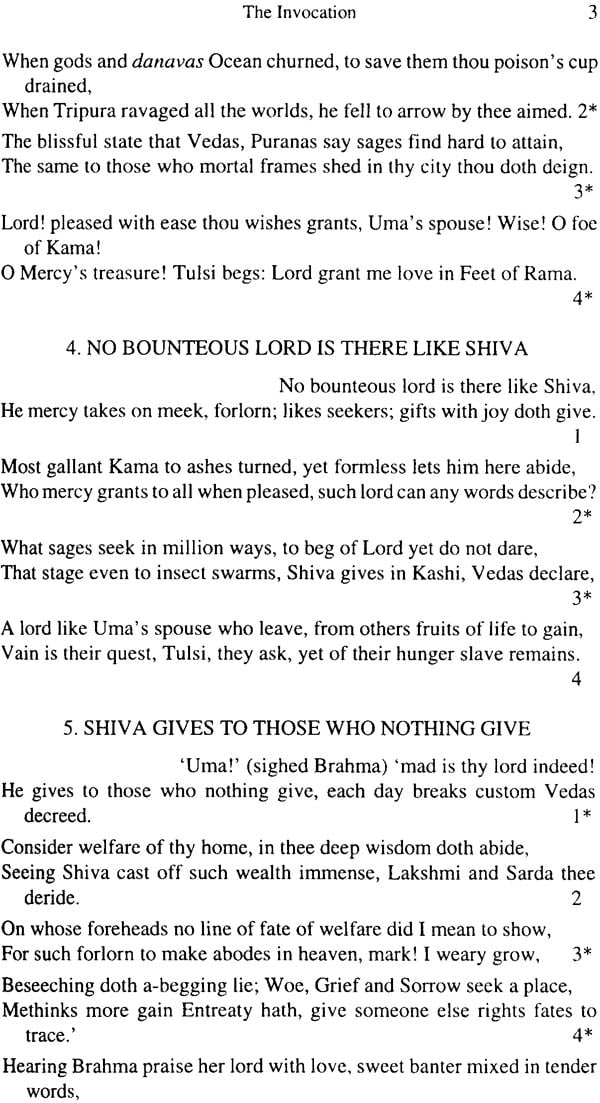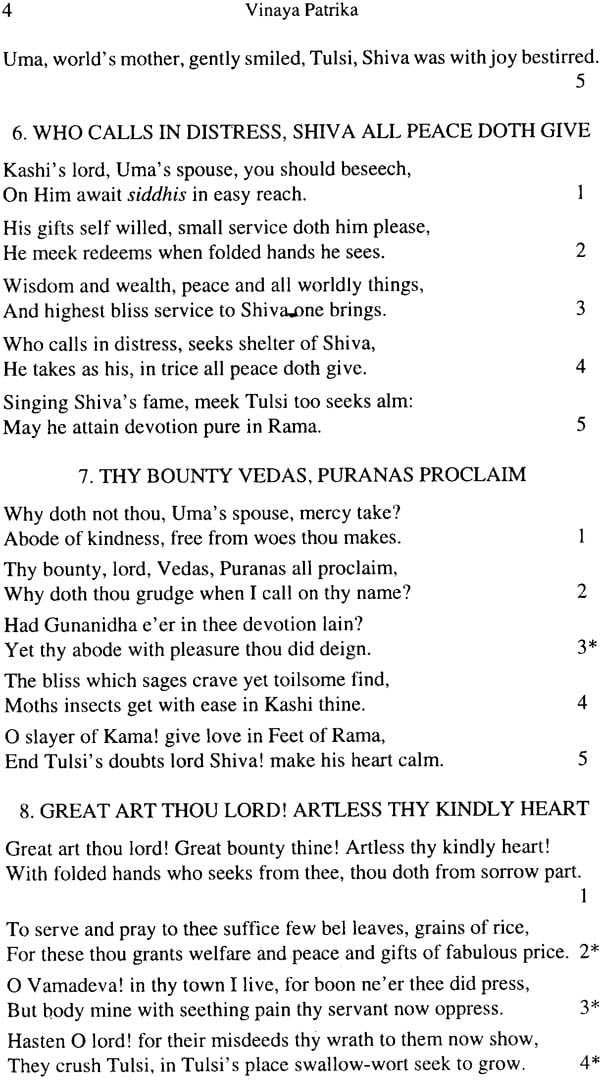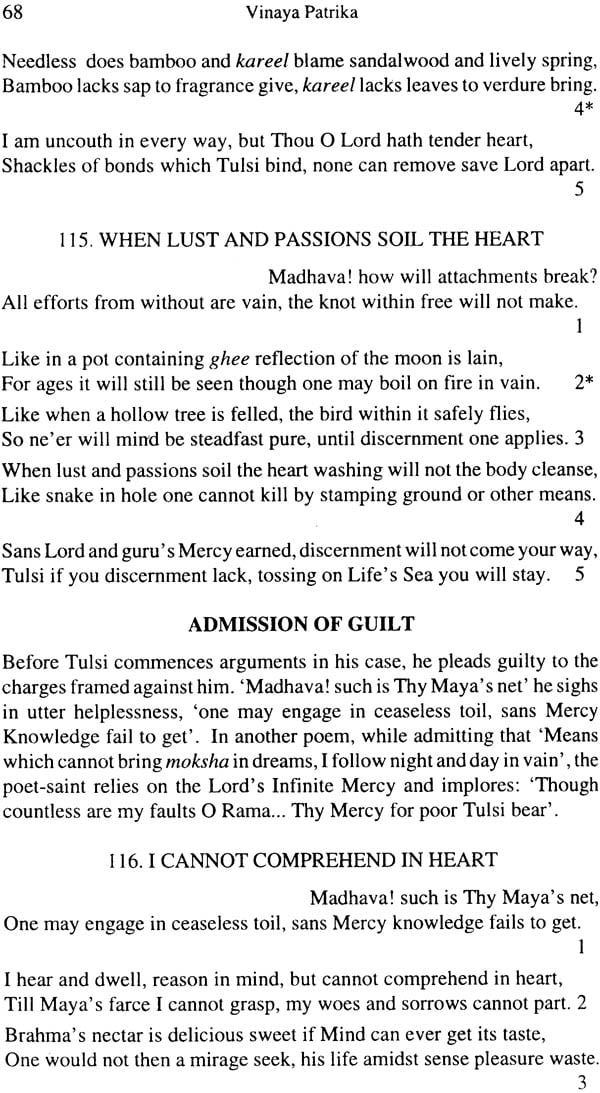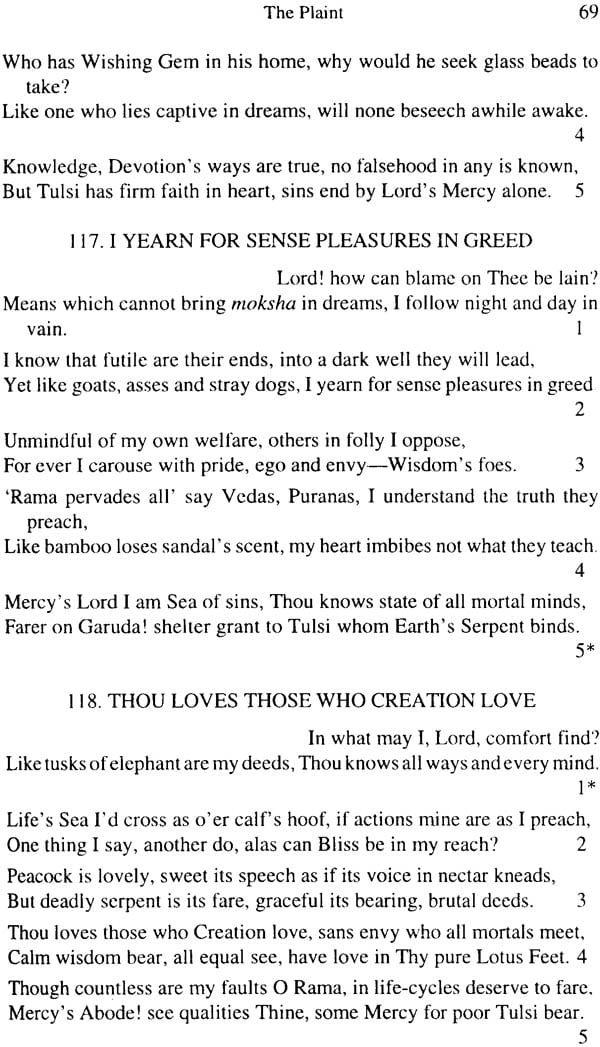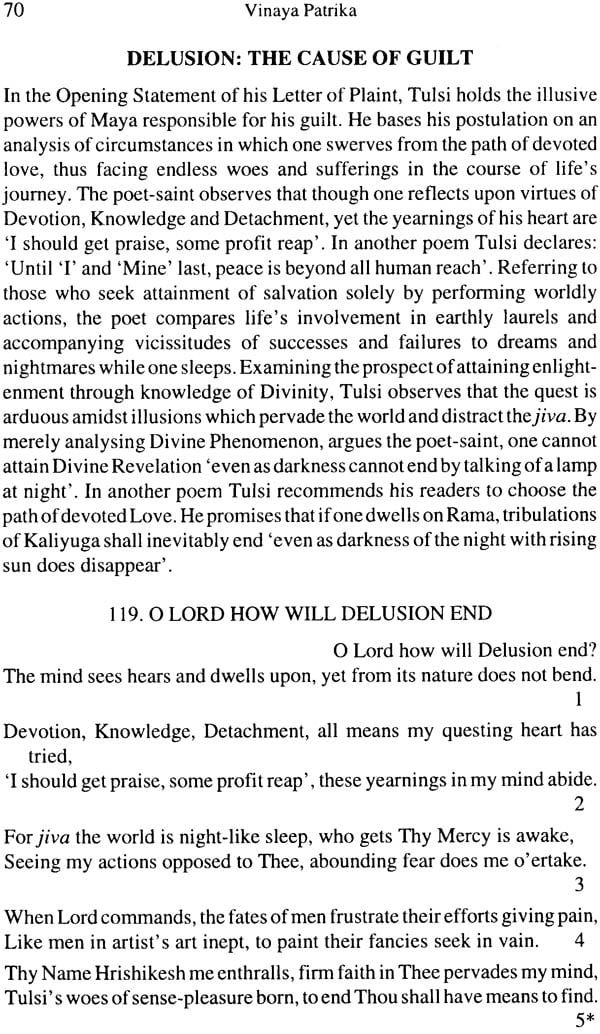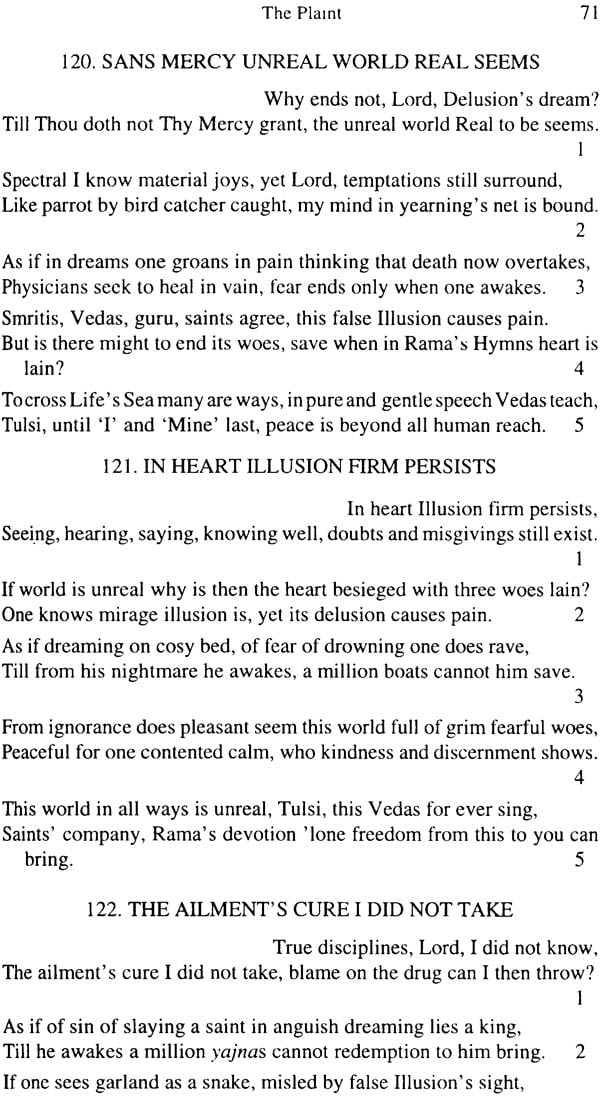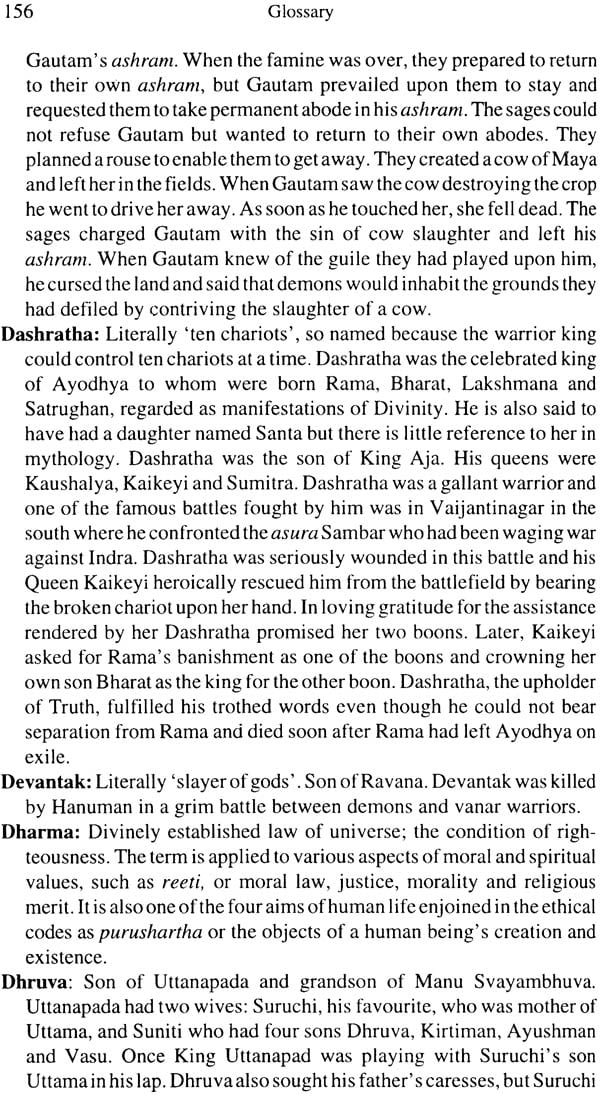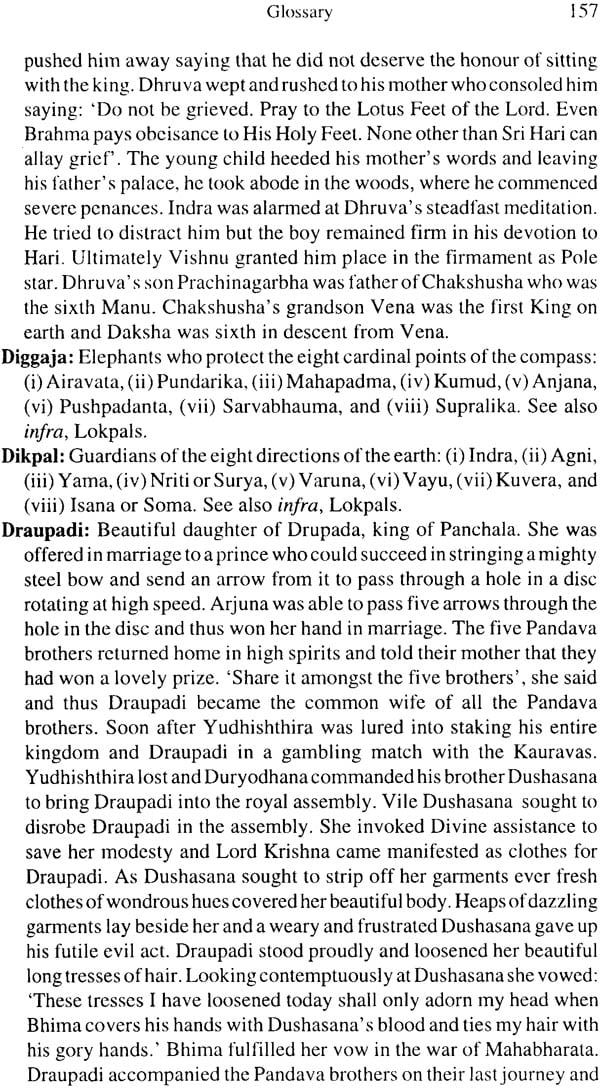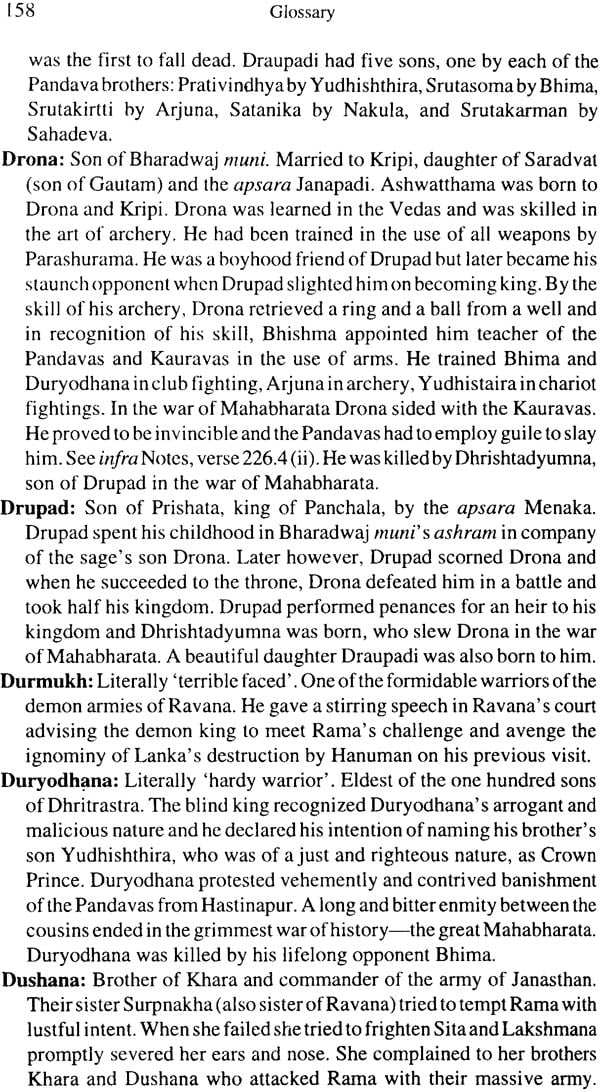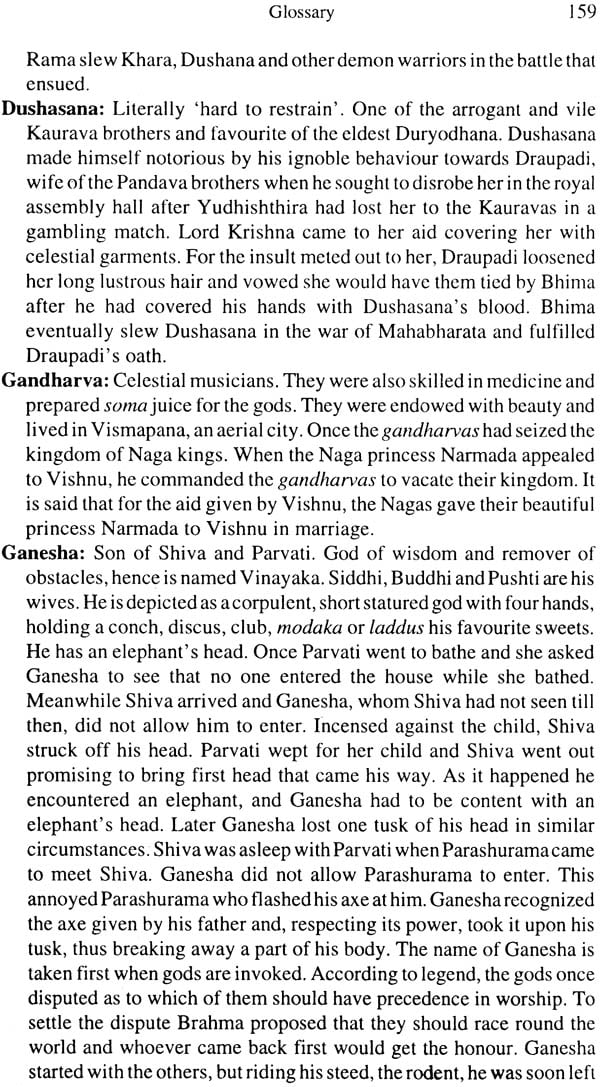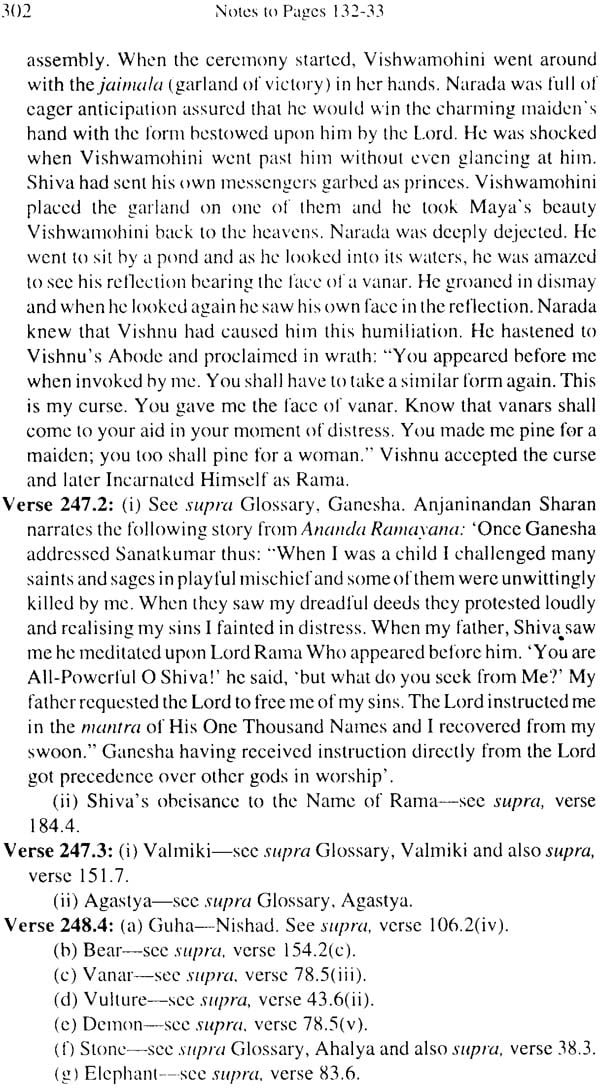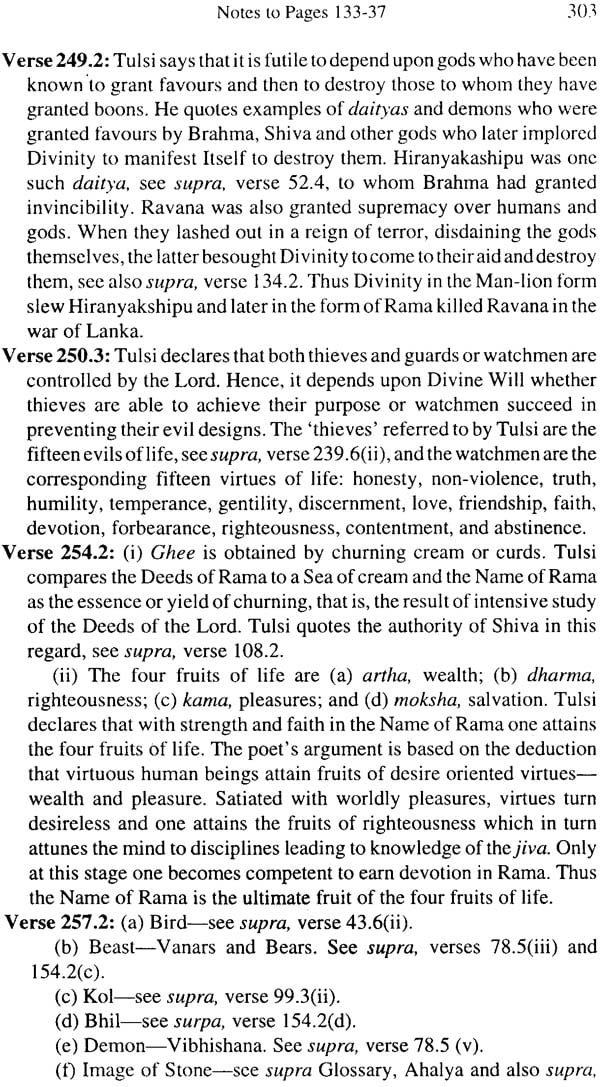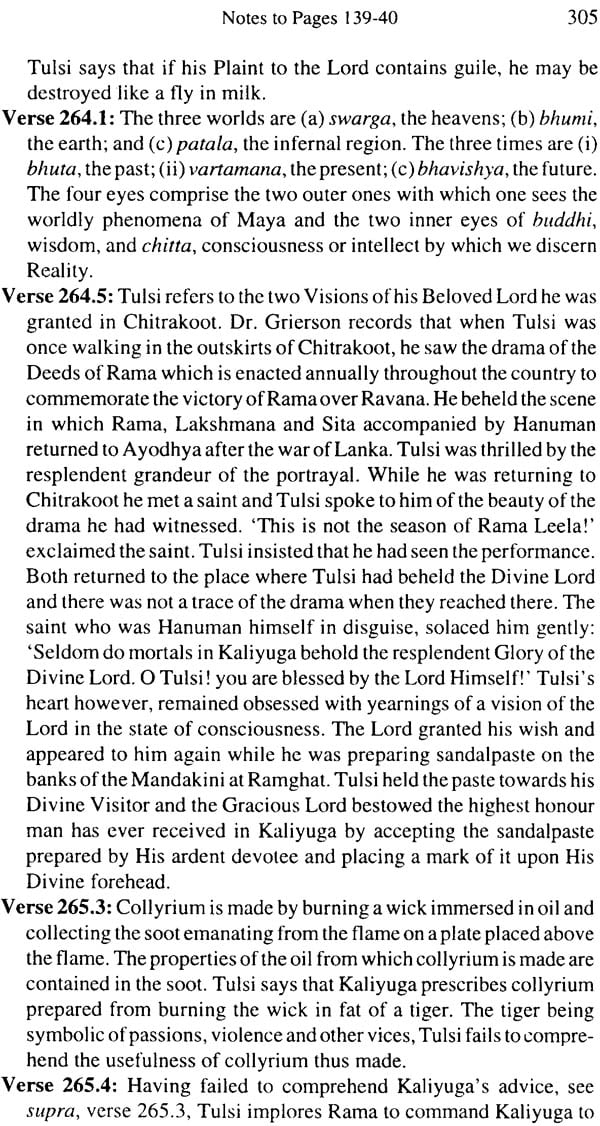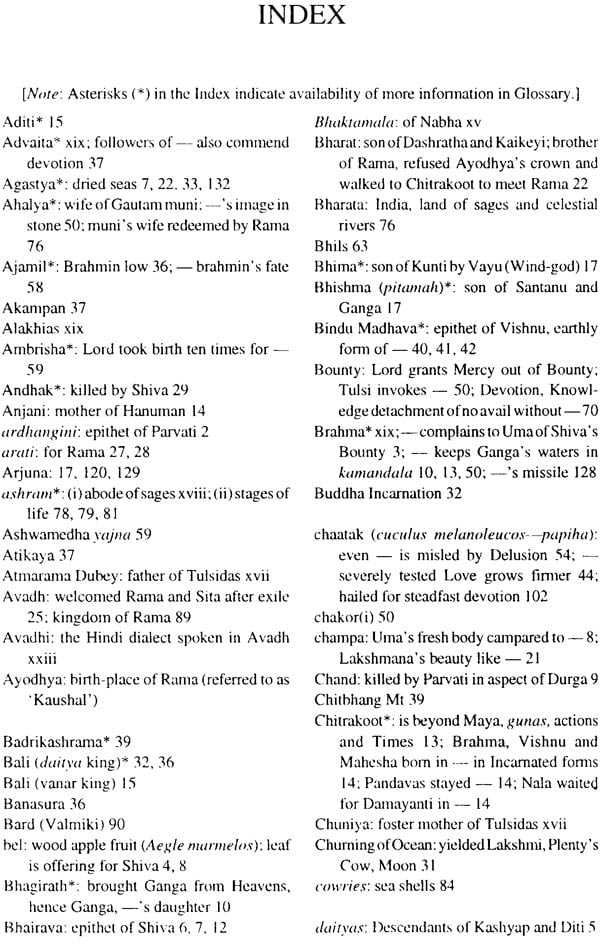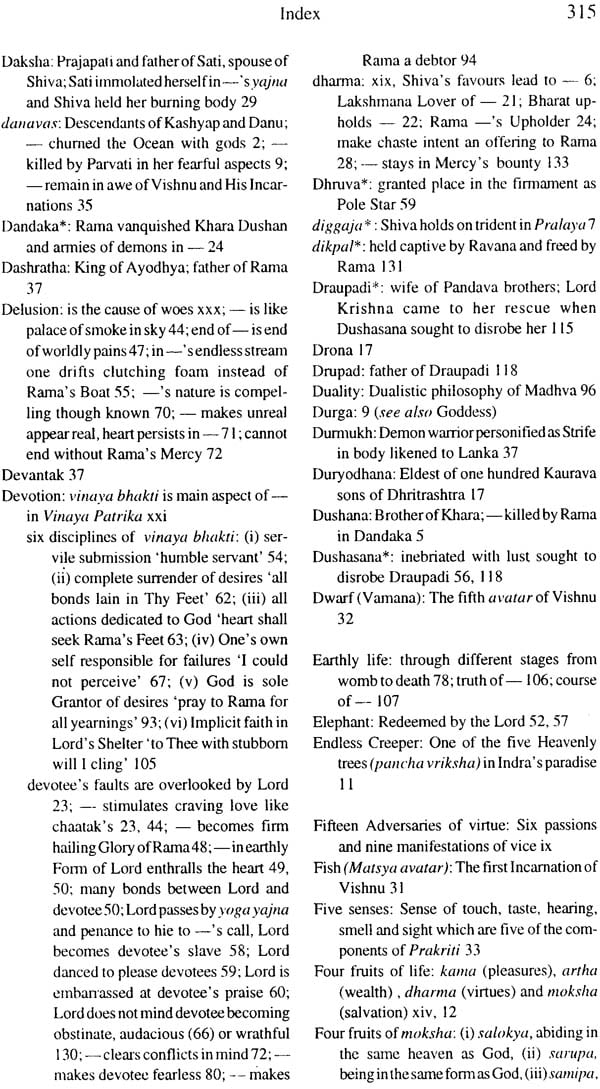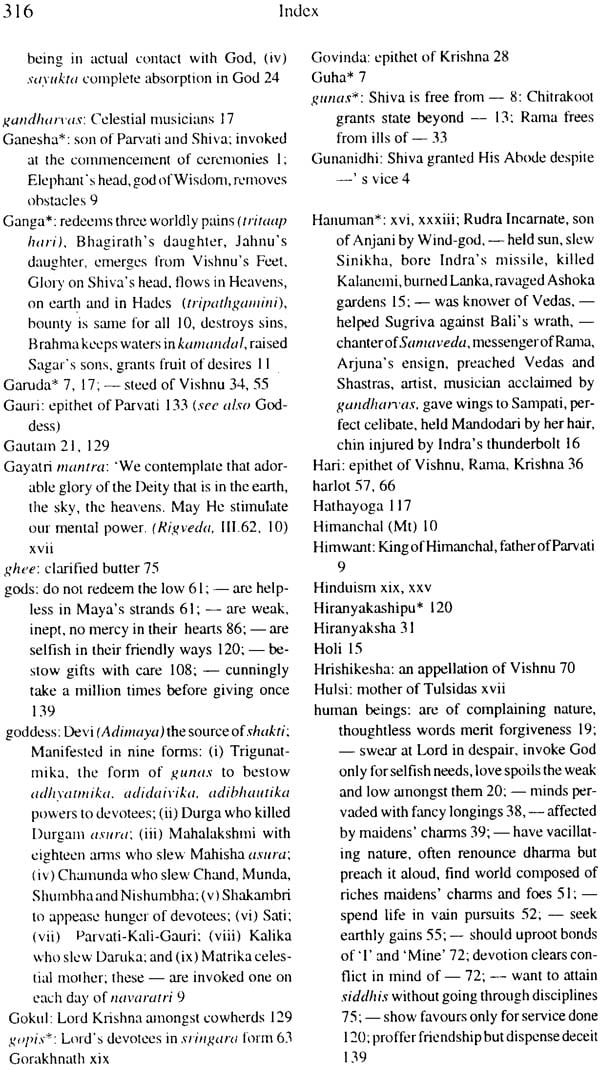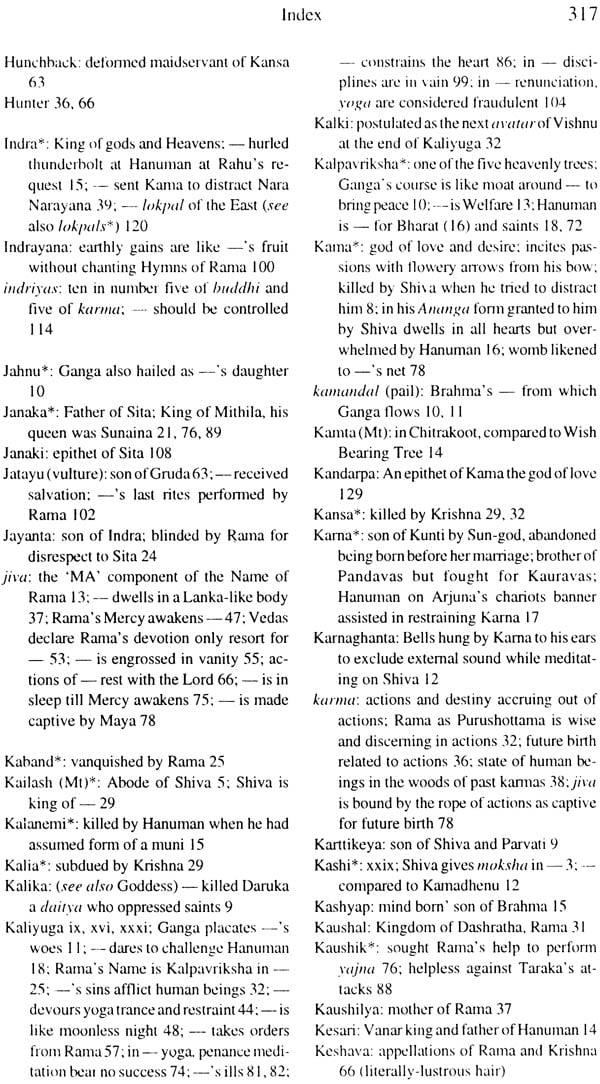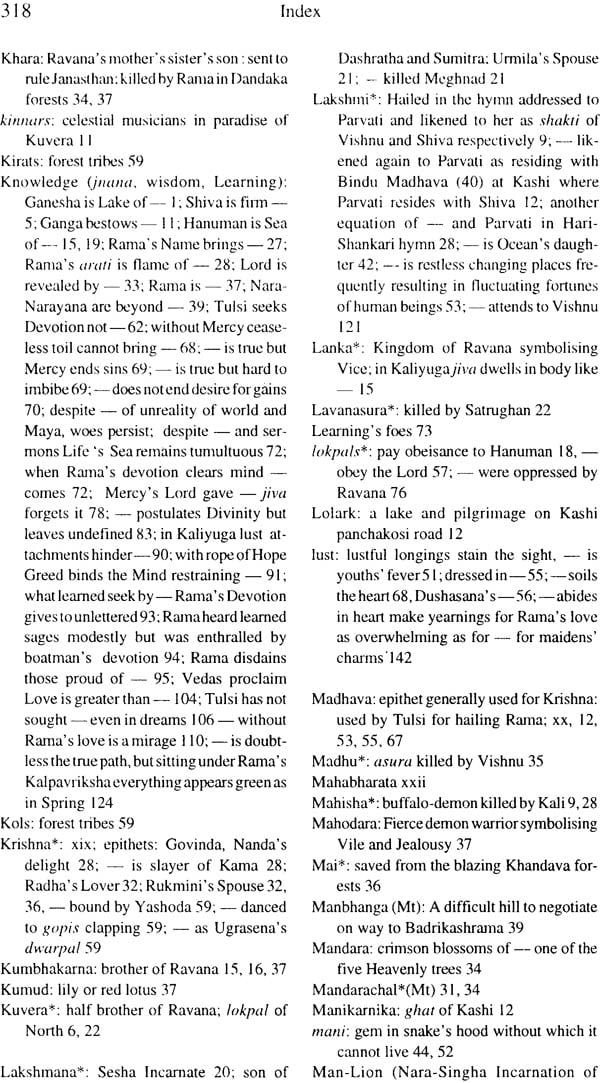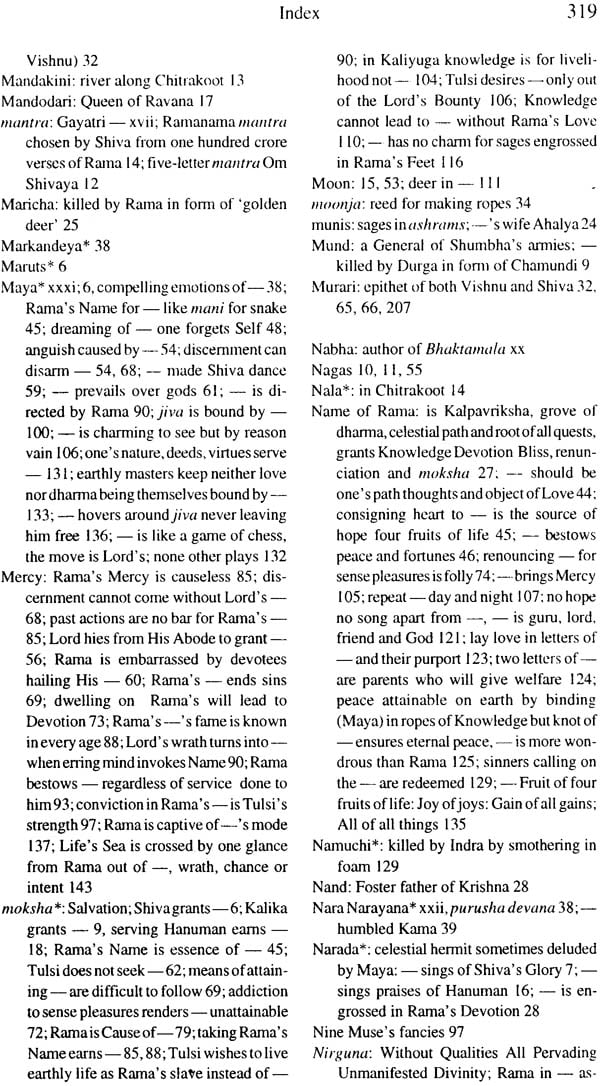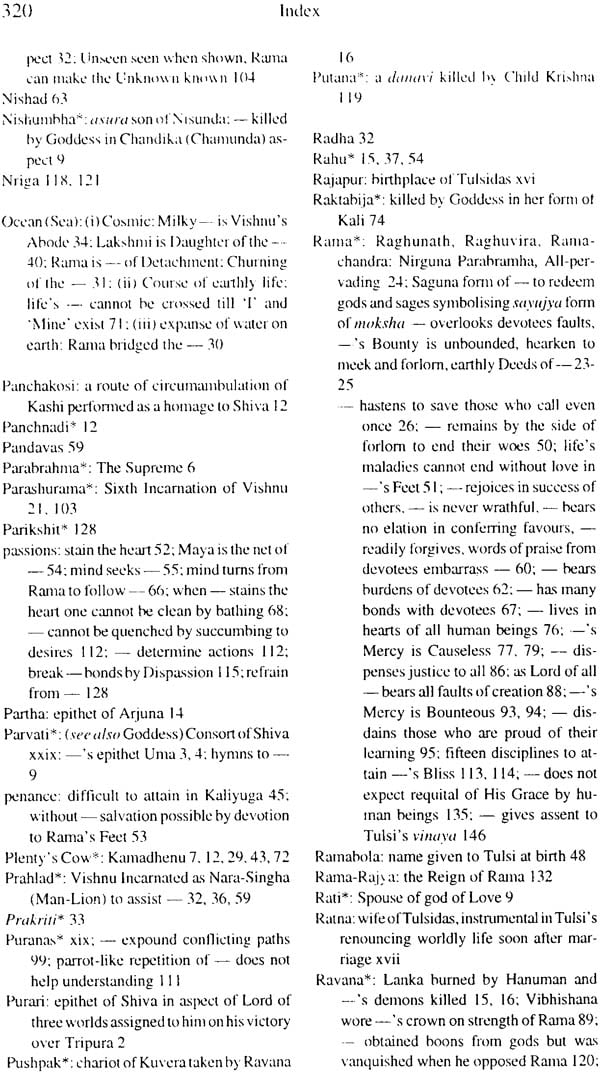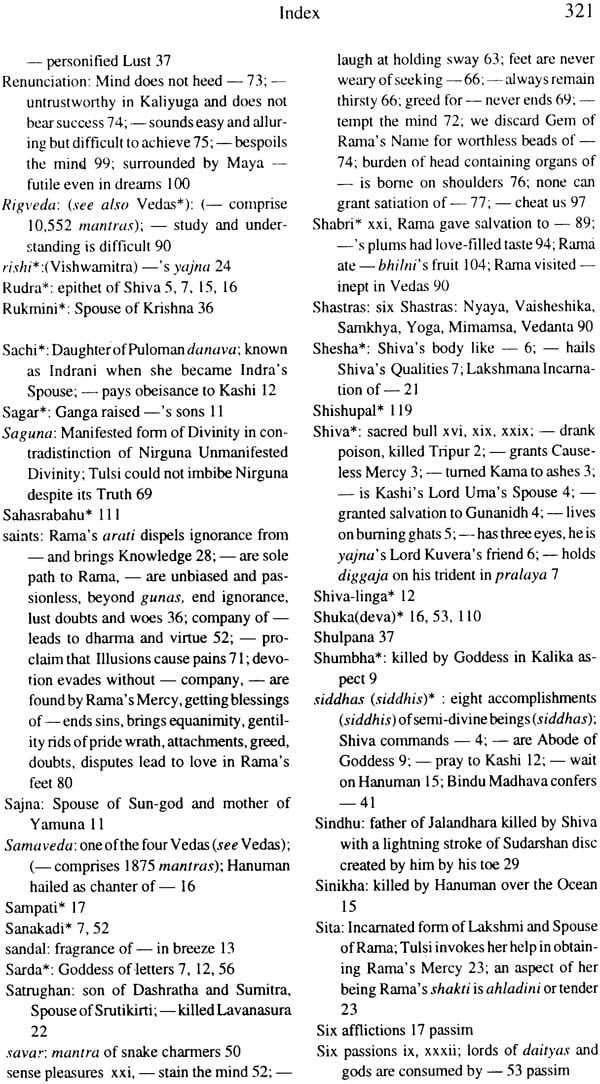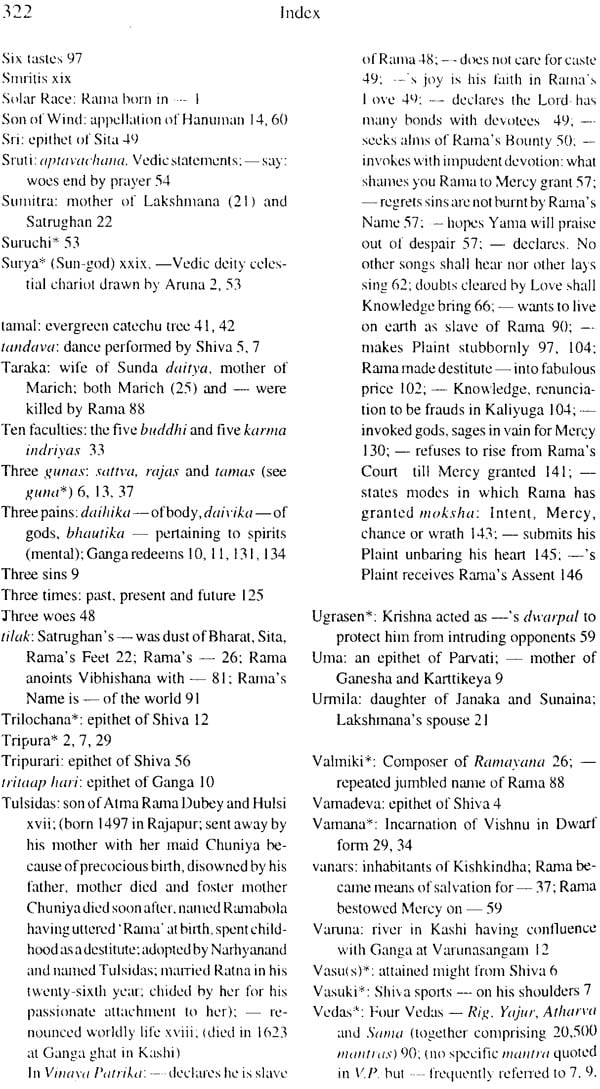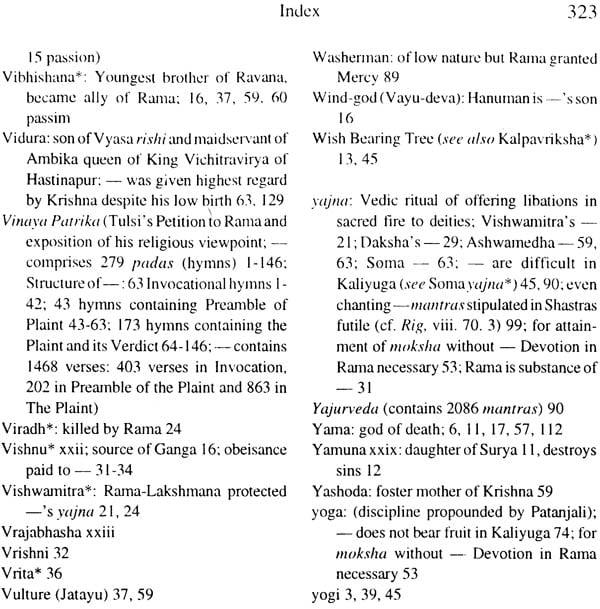
Vinaya Patrika (Vol. II from Complete Works of Goswami Tulsidas)
Book Specification
| Item Code: | ILL64 |
| Author: | Trans Into English By. S. P. Bahadur |
| Publisher: | MUNSHIRAM MANOHARLAL PUBLISHERS PVT LTD |
| Language: | English |
| Edition: | 1995 |
| ISBN: | 8121506506 |
| Pages: | 355 |
| Cover: | Hardcover |
| Other Details | 8.8 |
| Weight | 560 gm |
Book Description
About the Book
In Vinaya Patrika Tulsi submits a mercy petition in the court of Rama. Ostensibly he is the plaintiff but evidently he represents humanity. His complaint is against Kaliyuga who has abetted with maya to cause turbulence on earth driving mankind inexorably in the net of delusion and inevitable life-death cycles. In such times discernment through knowledge, yoga, renunciation have receded and bounty of Rama's Causeless mercy is the only recourse of redemption. Ramacharitmanasa is scripture of the Rama, Symbol of Divinity, Vinaya Patrika is a scripture of devotion in the Rama tradition. It is an important work for evaluating Tulsi's religious viewpoint. His hymns analyzing onslaught of 'adversaries of virtue', helplessness of mankind in withstanding passions, fervent prayers in thevinaya mode of devotion, cannot fail to reveal the infallibility of divine love, of which Tulsi was one of most ardent exponent. Vinaya Patrika has no thematic content but has many mythological reference. Asterisks (*) against verses in the text indicated availability of more information on these references in Explanatory Notes contained in the Volume.
About the Author
Shri S.P. Bahadur was born on 19th July 1926. he studied at the La Martinere College Lucknow, Universities of Lucknow and Roorkee. He visited Australia under Columbo Plan and retired as Chief Engineer, Irrigation Department, Uttar Pradesh in 1984. Born in a family devoted to the Rama tradition he received blessings and guidance in studies of Rama theology from his maternal uncle Mahatma Anjaninandan Sharan of Ayodhya, himself the author of exhaustive commentaries in Hindi on all literary works of Tulsidas Published by Gita Press.
Vinaya Patrika literally means 'A Letter of Imploration'. Tulsi's Vinaya Patrika comprises 279 hymns in the form of a 'Plaint for Mercy'. The poet-saint has preferred his petition in the Divine Court of Love. This being the first case submitted in Kaliyuga, it is being heard by the Full Bench of Judges of the Court. Lord Rama is the Presiding Judge. He has co-opted His Divine Consort Sita, who in her erstwhile role of 'daughter of the Earth' possesses specialised knowledge of the issues involved in the case. The Assisting Judges are Lord Bharat, himself the emblem of Devotion; Lord Lakshmana, Rama's most trusted and faithful compan- ion; and Lord Satrughan, the most fearless opponent of Vice. Goswami Tulsidas is the Plaintiff and Hanuman is his Counsel. Defendants in the case are the Six Passions: Lust, Wrath, Greed, Inebriation, Attachments, and Ego. Kaliyuga is the Counsel for the Defendants. The cause of action arose when the Plaintiff, who had engaged himself in devotion to his Beloved Lord (Bhakti,) was attacked by the Defendants, armed with formidable weapons of Illusive Sense Pleasures, seeking to prevent the Plaintiff from fulfilling his resolve. Tulsi finds himself ill-equiped in Knowledge (jnana) and feels that he does not bear the strength of virtuous actions (karma) to be able to meet the challenge of Sense Pleasures. He does not expect to get redress in Courts of gods where justice is dispensed according to merits of Knowledge and virtuous actions. Hence his Plaint in the Divine Court of Love in which only Mercy Petitions are admitted. From the earliest of times, disciples of the Lord have hailed Divinityin Hymns, translating the rapturous Bliss experienced in their hearts into exuberant expression in ecstatic rhapsody. These hymns in turn, stimulate extramundane environment and create resonance of Divine Thrill in the hearts to their readers and audiences, who experience a deep internal urge to seek Divinity, not in It's awesome Majesty, but in endearing bonds of Love and Devotion. Thus the depth and vitality of hymns of a religion is a measure of its effectiveness in establishing rapport between the Creator and His creation. When the mind and heart is so conditioned, human faith in Divinity becomes firmer, making attainment of the 'four fruits of life' surer, thus bringing a human being nearer to Divine Communion.
Tulsi is at his best in his hymns in Vinaya Patrika. It is his Plaint to his Beloved Lord whom he addresses as his Father, Mother, Son, Brother, Friend and Beloved. The compelling urgency of his importunate call for Divine Mercy reaches the innermost recesses of his readers' hearts and it is inevitable that they are attuned to the intensity of Tulsi' s own yearnings for Compassionate Mercy.
During our reading of the hymns of Vinaya Patrika my wife remarked that Tulsi's contribution to humanity is more outstanding in Vinaya Patrika than in Ramacharitmanasa. Explaining her viewpoint she ob- served that Ramacharitmanasa is admittedly a complete scripture con- taining all one needs to know on earth, butitis in VinayaPatrika that Tulsi brings conviction to human beings born in Kaliyuga that each one of us is eligible to receive Divine Mercy even though Knowledge, religious disciplines are beyond one's reach, provided that one heeds Tulsi's advice: 'No longer life I'll waste till now vain led'.
There is a greatness in the quality of Tulsi' s literary works that places him much above other Hindi poets and amongst outstanding poets of the world. A significant difference in the quality of works of famous men distinguish geniuses from celebrities. Some human beings attain emi- nence in their times and their names adorn pages of history dealing with the sphere in which they achieve distinction. Posterity admires and honours them for the roles they played in moulding or changing the course of destinies of people in their times. A select few of those born on earth however live beyond their times. Long after they have gone, their lives and works continue to thrill and influence human beings. Such men possess exacting qualities which characterise genius and make their names immortal. The beauty and freshness of their works is independent of passage of time; the rapture and inspiration derived from their lives is shared by a vast number of people rather than by a mere section of humanity; and not a single line of their compositions is unworthy of deepest study. As a corollary of the second and third criteria, it follows that the sum content of works of agenius cannot be imbibed in a single reading. That is to say, while the fragrance that pervades the work is readily discernible, its beauty dawns upon the mind gradually and grows lovelier on repeated readings.
Goswami Tulsidas belonged to the distinguished set of people who had such claim to genius. The great poet saint, born towards the close of the fifteenth century, has won the hearts of multitudes and has captivated the imagination of millions of people by the beauty of his compositions and the simplicity of his viewpoint on religion and morality. His literary works contain a rich effusion of thought and poetical art. His admirers are held amazed and spellbound at the fathomless depth of his love for Rama, the profoundness of his learning and the exquisite beauty of his literary expression. Nabha in Bhaktamala declared that Tulsi was 'Valmiki reborn in Kaliyuga'. Krishna Dutt in Gautam likened him to Mount Sumeru, and later critics hailed the distinguished poet as 'the moon of Hindi poetry'. But Tulsi's literary works proved to be loftier than Mount Sumeru and more brilliant than the silvery moonlight of the full moon. Traditions grew around this literary genius and apostle of the Lord to explain the immortal greatness of his works which appeared to be beyond human capability. Thus, in composing Ramacharitmanasa he is held to have received Hanuman's assistance and Vinaya Patrika is said to have been composed by him at the Son of Wind' s behest. Apart from his literary works, Tulsi's life also cilme to be associated with manifestations of Divine Pleasure. He is stated to have been carried in his mother's womb for twelve months and born with the name of Rama upon his lips. His biographers have recorded that he was blessed with two Visions of his beloved Lord Rama and at his request the Sacred Bull of Shiva at Kashi is reported to have eaten from the hands of a man accused of cow slaughter. This last mentioned miraculous incident is said to have enraged Kaliyuga who found Tulsi' s faith was converting millions of people into virtuous ways, thus vitiating his own efforts in propagating vice. Kaliyuga threatened the poet saint with destruction unless he promised to abstain from proclaiming the Divine Message of his Lord. Tulsi sought Hanuman' s counsel, who advised him to file a plaint in the Court of Rama, which Hanuman undertook to place before the Lord. It was in compliance of this advice that Tulsi is said to have composed his Vinaya Patrika, or Letter of Plaint.
Apart from this halo of Divine Blessing associated with Vinaya Patrika, it is also the poet's most outstanding work both in the beauty of his poetical art as well as in the overwhelming intensity of his devotional yearnings. Vinaya Patrika contains the compositions of the most mature and brilliant period of Tulsi's illustrious life. An ardent preacher of the path of devotion, he constantly urged his readers to beseech Lord Rama steadfastly 'in mind, in action and in speech' , for granting His Benign and Compassionate Mercy. In Vinaya Patrika, the apostle who devoted his entire life in enunciating this religious concept, himself becomes a plaintiff before Rama beseeching His Divine Mercy. Rarely if ever have hymns to the Lord been addressed with more compelling urgency and deeper and deeper devotion than in Tulsi' s Letter of Plaint. The great maestro and dedicated devotee is undoubtedly at his very best and Vinaya Patrika is not only the crowning glory of the illustrious poet's literary art but is also his most outstanding contribution to religion and humanity.
Very little is known of the birth and early life of Goswarni Tulsidas.1t is widely accepted thathe was born in 1497 on the seventh day of the month of Sravan in Rajapur, a small village in District Banda of Uttar Pradesh. He was named 'Ramabola' as he is said to have taken the name of Rama when he was born. His parents, Atma Rama Dubey and Hulsi, were dismayed at the birth of the precocious child who is said to have had fully grown teeth at birth. Hulsi contrived to send her new born babe away to her parents' home with her trusted maid Chuniya. The young infant's mother died shortly after his birth and the tender child was renounced by his father for the ill fate that befell his family after the babe was born. Ramabola was brought up by Chuniya at his maternal home, but when the child was five and a half years old, his foster mother died of snake bite. The young boy was now utterly forlorn and had to depend for sustenance on those who took pity on him. An unhappy childhood became indelibly etched in the poet's mind:
Food leavings like stray dog I licked, my anguished hunger ne' er allayed, Dwelling on Rama's name now I find a meal of nectar for me laid.
The grief of having been denied affection by his parents was also a painful memory in his later life:
My parents renounced me at the birth like insect on their bodies lain, Even my shadow none would cross, such was my fate, whom could I blame?'
So miserable indeed was the poet's childhood that later chroniclers of his life wondered how young Ramabola lived through his tender impres- sionable years. Tradition has it that Goddess Parvati herself tended the little child and she commanded saint Narhyanand in a dream to seek Ramabolaand instruct him in the scriptures. The saint found the child and was impressed by his amazing aptitude for religious enquiry. In 1504 Narhyanand performed the boy's sacred thread ceremony. Ramabola, who was then barely seven years of age, held learned priests spellbound by his fluent recitation of the Gayatri mantra in which he had not been instructed. Narhyanand gave Ramabola the name of Tulsidas by which the great poet came to be known thereafter.
| Genesis of the Plaint | ix |
| Article of the Plaint | xi |
| Foreword | xiii |
| Introduction | xv |
| Outline of Vinaya Patrika | xxvii |
| | |
| Hymns to Pilgrimages 10 Hymns to Ramayana 14 Hymns to Vishnu Creation 31 | 1 |
| | |
| Resolution on Plaint 46 | 43 |
| | |
| The Letter of Plaint 100 | 64 |
| Glossary | 147 |
| Explanatory Note | 217 |
| Index of Titles of Hymns | 308 |
| Index | 314 |
